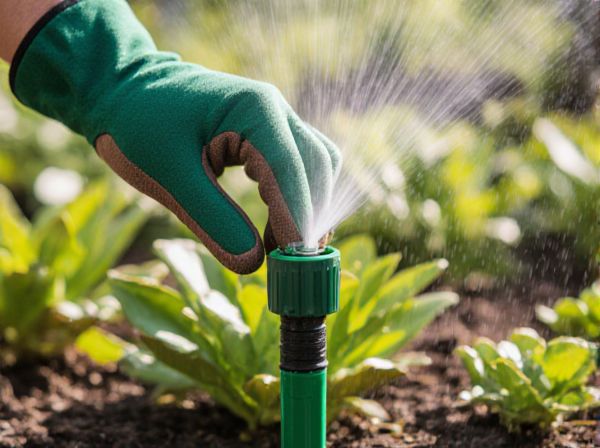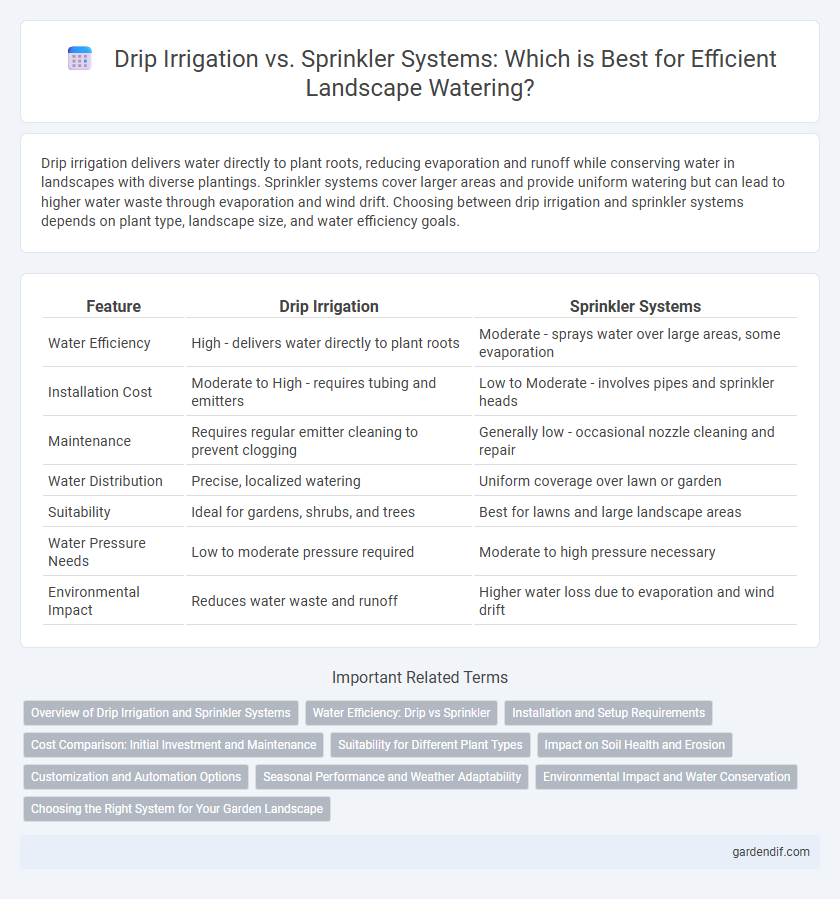
Drip Irrigation vs Sprinkler Systems Illustration
Drip irrigation delivers water directly to plant roots, reducing evaporation and runoff while conserving water in landscapes with diverse plantings. Sprinkler systems cover larger areas and provide uniform watering but can lead to higher water waste through evaporation and wind drift. Choosing between drip irrigation and sprinkler systems depends on plant type, landscape size, and water efficiency goals.
Table of Comparison
| Feature | Drip Irrigation | Sprinkler Systems |
|---|---|---|
| Water Efficiency | High - delivers water directly to plant roots | Moderate - sprays water over large areas, some evaporation |
| Installation Cost | Moderate to High - requires tubing and emitters | Low to Moderate - involves pipes and sprinkler heads |
| Maintenance | Requires regular emitter cleaning to prevent clogging | Generally low - occasional nozzle cleaning and repair |
| Water Distribution | Precise, localized watering | Uniform coverage over lawn or garden |
| Suitability | Ideal for gardens, shrubs, and trees | Best for lawns and large landscape areas |
| Water Pressure Needs | Low to moderate pressure required | Moderate to high pressure necessary |
| Environmental Impact | Reduces water waste and runoff | Higher water loss due to evaporation and wind drift |
Overview of Drip Irrigation and Sprinkler Systems
Drip irrigation delivers water directly to plant roots through a network of tubes and emitters, maximizing water efficiency and minimizing evaporation and runoff. Sprinkler systems distribute water over a wide area by spraying it into the air, simulating rainfall, and are ideal for lawns and larger garden spaces. Both systems have distinct advantages, with drip irrigation suited for precise watering in gardens and drip zones, while sprinklers provide broader coverage for turf and diverse landscapes.
Water Efficiency: Drip vs Sprinkler
Drip irrigation systems use up to 50% less water than sprinkler systems by delivering water directly to plant roots, minimizing evaporation and runoff. Sprinkler systems often lose water due to wind drift and surface runoff, reducing overall irrigation efficiency. Choosing drip irrigation enhances water conservation in landscapes, especially in drought-prone areas requiring precise moisture control.
Installation and Setup Requirements
Drip irrigation systems require precise placement of tubing and emitters at the root zone, often necessitating professional design to ensure efficient water delivery and minimize waste. Sprinkler systems involve installing heads and connecting them to a pressurized water source, with setup complexity varying based on zoning and coverage area. Both systems demand careful planning, but drip irrigation typically involves more intricate initial setup due to the customization of emitter locations.
Cost Comparison: Initial Investment and Maintenance
Drip irrigation systems generally require a higher initial investment due to the need for extensive tubing and emitters, but they offer lower maintenance costs by reducing water waste and minimizing system repairs. Sprinkler systems, while typically less expensive to install, often incur higher maintenance expenses because of frequent valve replacements, nozzle clogs, and water pressure issues. Over time, drip irrigation proves more cost-effective for landscapes looking to optimize water usage and reduce long-term operational expenses.
Suitability for Different Plant Types
Drip irrigation delivers water directly to the root zone, making it ideal for shrubs, trees, and row crops that require precise moisture control and minimal foliage wetting. Sprinkler systems distribute water over a broad area, better suited for lawns, ground covers, and flower beds that thrive with uniform surface watering. Selecting the appropriate system depends on plant water requirements, root depth, and landscape design to maximize efficiency and plant health.
Impact on Soil Health and Erosion
Drip irrigation delivers water directly to the root zone, minimizing surface runoff and reducing soil erosion while promoting healthier soil structure through consistent moisture levels. In contrast, sprinkler systems distribute water over a larger area, which can lead to increased surface runoff, soil compaction, and higher erosion rates, especially on sloped landscapes. Efficient water delivery with drip irrigation enhances nutrient retention and microbial activity, crucial for sustaining robust soil health and preventing degradation.
Customization and Automation Options
Drip irrigation systems offer precise customization by delivering water directly to plant roots, minimizing waste and supporting tailored watering schedules for diverse plant types. Sprinkler systems provide automation through programmable timers and zone controls, covering larger areas with adjustable spray patterns to accommodate lawn and garden layouts. Advanced smart controllers integrate with weather data, optimizing water use efficiency in both systems while enhancing landscape health and sustainability.
Seasonal Performance and Weather Adaptability
Drip irrigation systems provide precise water delivery directly to plant roots, optimizing efficiency during dry and hot seasons by minimizing evaporation and runoff. Sprinkler systems offer broader coverage suitable for varied landscapes, performing well during moderate rainfall but potentially losing efficiency in windy or cooler conditions. Seasonal performance favors drip irrigation in arid climates due to water conservation, while sprinklers adapt better to fluctuating weather with uniform surface coverage.
Environmental Impact and Water Conservation
Drip irrigation delivers water directly to plant roots, minimizing evaporation and runoff, resulting in up to 50% greater water efficiency compared to sprinkler systems. Sprinkler systems often cause water loss through misting and overspray, leading to increased water consumption and higher environmental strain. Choosing drip irrigation supports sustainable landscaping by reducing water waste and conserving vital resources in arid and drought-prone areas.
Choosing the Right System for Your Garden Landscape
Drip irrigation delivers water directly to plant roots, reducing evaporation and promoting efficient water use ideal for garden beds and shrubs. Sprinkler systems cover larger areas evenly, making them suitable for lawns and landscapes requiring broad, uniform hydration. Selecting the right system depends on plant types, garden layout, soil conditions, and water conservation goals to optimize landscape health and resource management.
Drip Irrigation vs Sprinkler Systems Infographic

 gardendif.com
gardendif.com